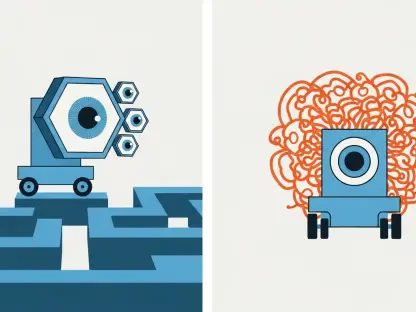Market Context: The Rising Burden of AI Deployment
The enterprise AI landscape is at a critical juncture, with costs spiraling out of control as businesses race to integrate generative AI into their operations. Reports indicate that the computational demands of training and maintaining large language models (LLMs) can run into millions of dollars annually for a single organization, creating a barrier to entry for smaller players and straining budgets even for industry giants. This financial crunch, coupled with growing environmental concerns over energy-intensive AI systems, underscores the urgent need for innovative solutions. The focus of this market analysis is to evaluate whether Continuous Autoregressive Language Models (CALM), a novel architectural design, can disrupt the status quo by slashing these prohibitive expenses. By examining current trends and future projections, this analysis aims to provide clarity on how efficiency-driven innovations could reshape the economics of AI adoption across industries.
In-Depth Market Trends and Projections
Escalating Costs and the Push for Efficiency
Enterprise AI deployment has seen a dramatic uptick in recent years, driven by the transformative potential of LLMs in automating tasks from data analytics to customer engagement. However, the market faces a stark reality: the traditional token-by-token text generation process of autoregressive models is computationally expensive, especially for sectors like finance and IoT that process vast, real-time data streams. Industry data suggests that training costs for a single high-performing model can exceed significant thresholds, while inference expenses compound over time. This trend has sparked a shift in market dynamics, with businesses increasingly prioritizing cost-effective architectures over sheer model size, setting the stage for innovations like CALM to gain traction.
CALM’s Architectural Edge: A Game-Changer in Compute Costs
At the core of CALM lies a pioneering approach that moves away from discrete token prediction to generating continuous vectors, compressing multiple tokens into a single representation using a high-fidelity autoencoder. Experimental findings reveal that grouping four tokens into one vector allows CALM to match the performance of traditional models while reducing training FLOPs (floating-point operations) by 44% and inference FLOPs by 34%. For enterprises, this translates into substantial savings on cloud computing bills and energy consumption, addressing a critical pain point in the market. While still in the research phase, this efficiency gain positions CALM as a potential disruptor, particularly for industries seeking scalable solutions without the overhead of massive computational infrastructure.
Compatibility Challenges and Market Adoption Barriers
Despite its promise, CALM faces hurdles in penetrating the enterprise AI market due to compatibility issues with existing tools designed for discrete vocabularies. To counter this, a likelihood-free framework has been developed, replacing conventional methods like softmax layers with an Energy Transformer and introducing BrierLM as a new performance metric based on the Brier score. This framework also supports controlled generation through a novel sampling algorithm, a feature vital for tailored enterprise applications. However, market analysts caution that adoption may be slow as companies hesitate to overhaul established workflows for an untested methodology, highlighting the need for vendors to bridge the gap between research and practical implementation.
Sector-Specific Implications and Scalability Potential
The impact of CALM varies across market segments, with data-intensive sectors like financial services poised to benefit most from reduced computational loads during real-time analysis. In contrast, lighter applications such as customer support chatbots may see more modest gains, though still significant in aggregate cost savings. Edge computing environments, where resources are constrained, present another challenge, as CALM’s efficiency must be proven in low-power settings. Looking ahead, market projections suggest that within the next few years, from 2025 to 2028, vendor solutions inspired by CALM could emerge, tailored to specific industry needs, provided that ongoing research addresses scalability and integration concerns.
Industry Shift Toward Sustainable AI Scaling
A broader market trend reflected in CALM’s development is the pivot away from scaling AI through parameter bloat, which often yields diminishing returns, toward architectural efficiency as a competitive differentiator. Semantic density per generative step is becoming a key metric for evaluating AI solutions, aligning with regulatory pressures to curb the carbon footprint of data centers. Forecasts indicate that efficiency-driven designs could dominate enterprise AI strategies over the next decade, as sustainability becomes a boardroom priority. This shift is expected to encourage technology providers to innovate around FLOPs per token rather than raw compute power, reshaping market offerings in profound ways.
Strategic Reflections and Market Recommendations
Looking back, this analysis delved into how the enterprise AI market grappled with unsustainable cost structures, positioning CALM as a potential catalyst for change through its vector-based text generation and efficiency gains. The examination revealed that while immediate adoption faced technical and cultural barriers, the long-term outlook pointed to a market increasingly receptive to sustainable, cost-effective architectures. For businesses, the next steps involve closely monitoring advancements in CALM-inspired frameworks and initiating pilot projects to test efficiency-focused designs in controlled environments. Partnering with forward-thinking vendors who emphasize innovation over scale emerges as a prudent strategy to stay competitive. Additionally, companies are encouraged to reassess their AI investment priorities, balancing performance needs with resource constraints to align with an evolving market landscape focused on smarter, greener solutions.









